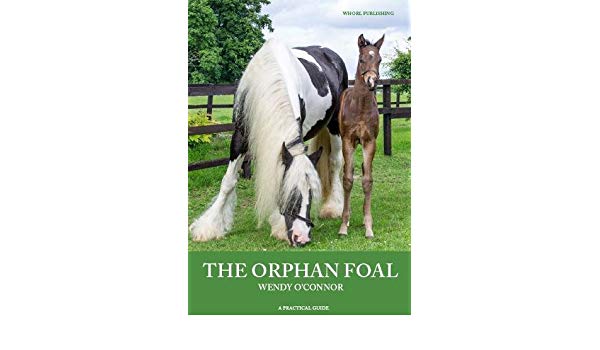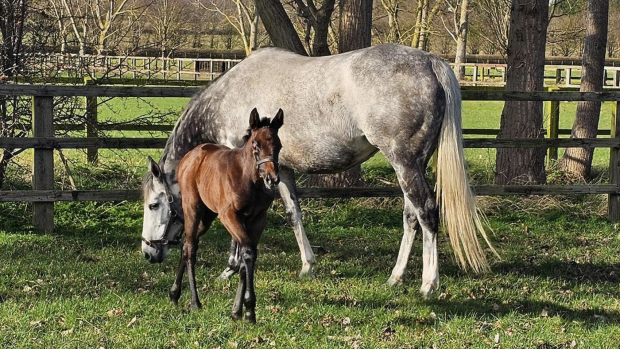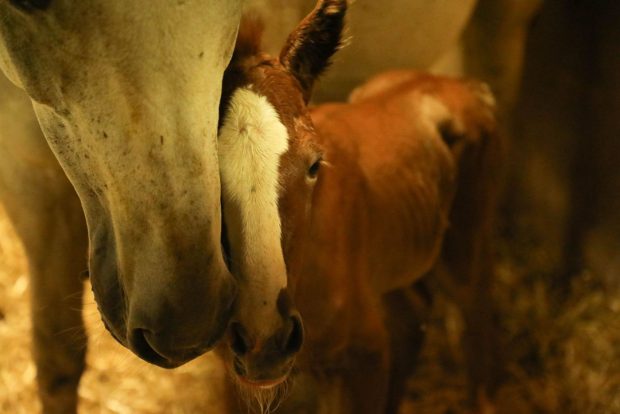The Orphan Foal: A Practical Guide is a book written to explain how a foal should be cared for if the dam is unable or unwilling to feed her foal.
Author Wendy O’Connor has over 45 years’ experience of working with horses. She spent 30 years on stud farms and the remaining with the racing industry. Wendy has assisted with hundreds of foalings, most of which have gone very smoothly, resulting in a healthy mare and foal. However, when things have gone wrong, for example if the mare rejects the foal, Wendy has developed the skills necessary for caring for the mare and/or foal. She is renowned all over the UK for fostering and hand-rearing orphan foals and has given lectures on her methods.
The skills Wendy has acquired are passed on in this book. Time is of the essence when things go wrong and this book will be a valuable guide to anyone involved in breeding horses, whether professionally or for pleasure.
Deidre Carson BVSc MRCVS said of this book: “There is no baffling science but reassuring reference to the need to take professional veterinary advice if needed. This book covers all of the basics and more and would be an excellent addition to the reading material for stud managers and stud employees plus the amateur breeder who wants to ensure they have access to some sensible, practical advice on rearing a foal when things haven’t gone to plan. Vets and vet students will also find it useful if they are unfamiliar with these situations.”
This book explains how to foster an orphan foal, how to hand-rear an orphan foal, how to integrate and educate an orphan foal with other horses and how a foal should be cared for if its dam us unable to feed it.

In this book extract, Wendy explains her top tips for success when fostering a foal:
– Make sure the foal has not been fed for a while before you start i.e, it must be hungry. It depends on the age but foals less than two weeks old can be left a couple of hours before introducing them. Older foals can be left about three hours. When the first foal arrives (if the foal comes to your mare) enquire when it last drank so you know how long it can safely go without food.
– If the foal has never drunk from a mare before you will need to show it where the udder is and encourage it to latch onto the teat. You can start by trying to squirt milk into the foal’s mouth, taking care to avoid aspiration pneumonia. This is one of those times when you will need a lot of patience. If the foal has only every drunk from a bucket or has done so for a long time and won’t latch on to the teat, try feeding it from a bottle to get the suck reflex going. Once it has learnt to latch on and suck from the bottle, progress to the mare’s teat.
– Always put foals on a one week course of equine probiotic paste. This is because the trauma of losing their dam, the stress of fostering and the change in diet may cause digestive upsets and probiotics may help.
– Some mares do not like having too many bales of straw around them and will try to jump out, so be flexible to individual needs.
– Each fostering is different — there are no hard and fast rules.
– Work with the mare and foal as individuals until you understand their likes and dislikes.
-The fostering process may take anything from a couple of hours to over a week.
– Normally an experienced handler can asses whether the process is going to work or not.
– It sometimes helps to try taking the foal away from the mare after a couple of hours and watch her reaction to see if she misses the foal. If she whinnies and looks for the foal, you’re onto a winner. Do not despair if she doesn’t, there is still plenty of time.
– Not all attempts at fostering work.
– Always have a supply of formula (equine substitute) milk available in case the mare’s milk supply is inadequate and the foal needs to be supplemented.
– If the mare has poor milk supply, supplement her feed with cocoa powder (from the local shop). Make sure it is full strength cocoa powder and not low calorie or drinking chocolate. Mix four tablespoons of powder with her night feed. Start with one spoonful then build up as she gets used to the taste. Your vet may also advise treating her with Domperidone (an anti-sickness medication that has a side effect of her usually stimulating milk supply) and she should be fed plenty of fresh cut grass. Your vet may also suggest using prostaglandin if the mare is not pregnant again, which is a relatively new protocol and can give good results. These methods will hopefully encourage the mare to produce more milk so if contemplating these forms of treatment, consult your vet.
– Any change in a foal’s diet can cause it to scour.
– Anti-diarrhoea preventive medicine and probiotics may be advisable until recovered.
Price: The Orphan Foal: A Practical Guide can be purchased for £20 via Whorl Publishing
Published by: Whorl Publishing Limited, 2018
For all the latest equestrian news and reports, don’t miss Horse & Hound magazine out every Thursday




